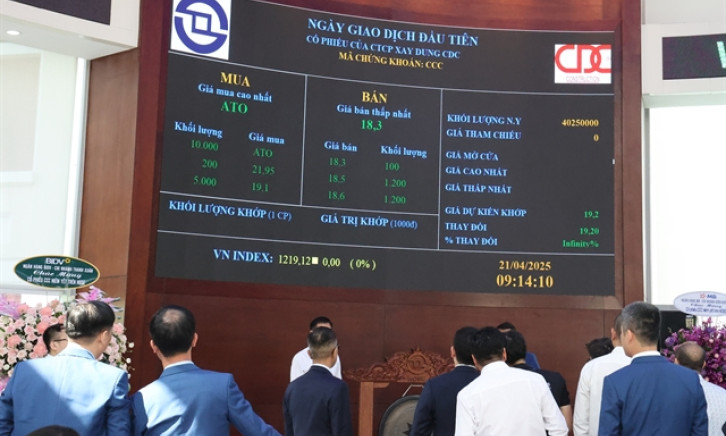Vietnam hotpot culture boasts full-spectrum flavors
Vietnamese hotpots are more than just food. They are a way of sharing, bonding and celebrating among loved ones: be it friends, family, neighbors, or even coworkers.
So let's explore the variety and richness of these dishes.
Lau ga la e - Chicken hotpot with e leaves
Lau ga la e is a delicious Vietnamese chicken stew that features a special herb called la e, or lemon basil leaves. This herb has a unique aroma that gives the dish its characteristic flavor. The stew also contains bamboo shoots, mushrooms, bird's eye chilies and various spices that enhance the taste and texture of the dish.
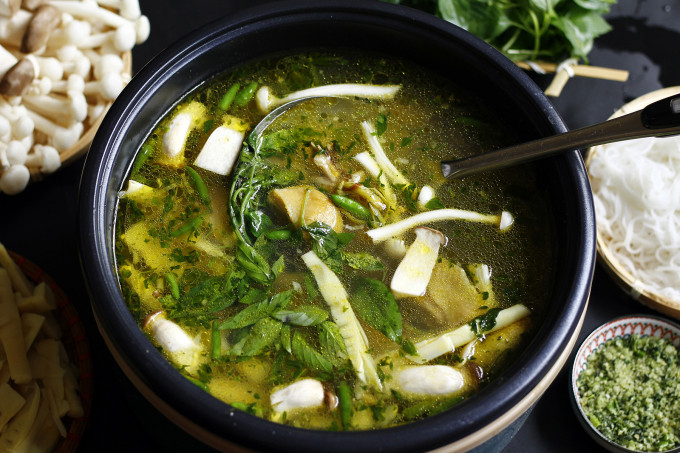
The broth is savory and sweet, with a hint of sourness. The bamboo shoots add some crunch and earthiness to the dish, while the fresh e leaves provide a burst of herbal aroma and a slight bitterness that balances the richness of the broth. The leaves cook quickly, so do not leave them in the broth too long.
This dish originates from Phu Yen Province in central Vietnam, where the leaf grows abundantly in the sandy soil and sunny climate. It is also a popular dish in Da Lat in the Central Highlands, where many eateries offer it as their specialty. It is ideal on cold or rainy days – it warms up the body with its spiciness and fragrance.
Lau mam - hotpot with fermented fish
Lau mam is a type of hotpot with fermented fish that originated in the Mekong Delta. The dish features a variety of seafood, meat and vegetables cooked in a broth made from mam (fermented fish). The broth is seasoned with sugar, salt, lemongrass, garlic, shallots and chili to create a savory, sweet and spicy flavor.
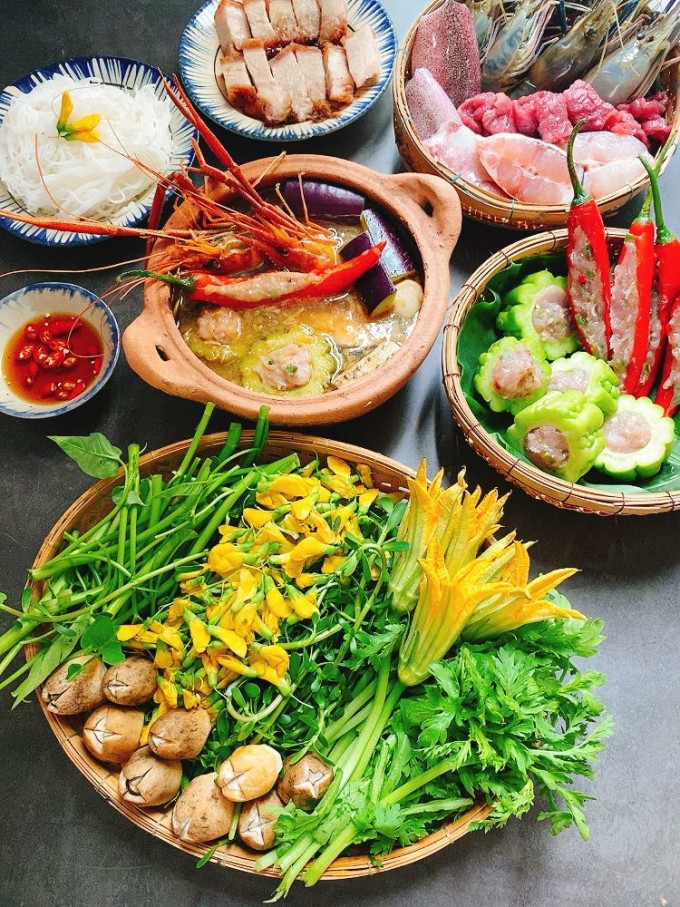
The taste of lau mam is a mix of salty fermented fish sauce, sweet and sour pineapple, and hot chili peppers. A spoonful of mam is enough to fill a room (or a house!) with its pungent scent when added to the hotpot broth. The flavor is complex and balanced, creating a satisfying experience for both veteran eaters and first timers alike.
Some of the common toppings used in lau mam are pangasius fish fillet, shrimp, squid, and roasted pork belly. Various kinds of herbs and vegetables such as eggplant, water spinach, riverhemp, squash blossom, and water lily stems are also served alongside the dish. The dish is popular among locals and tourists for its rich and unique flavor that reflects the variety and abundance of wetland ingredients found in the Mekong Delta.
Lau ca keo - Rafter fish hotpot
Rafter fish hotpot is another hotpot dish from the Mekong Delta. It is made with ca keo, also known as rafter fish, a freshwater fish that lives in the muddy waters of the river. The fish has a long and slender body, with firm and sweet flesh.
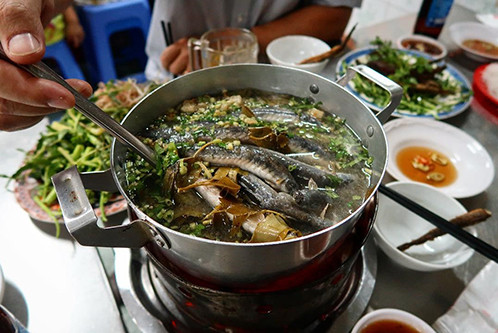
The fish is cleaned, cut into pieces and marinated with salt, sugar, turmeric and fish sauce. The broth is prepared by boiling water with lemongrass, tamarind, pineapple, tomato and chili. The fish is then added to the broth and cooked until tender. The hotpot is served with rice noodles, fresh herbs and fish sauce.
The flavor of lau ca keo is a combination of sour from the tamarind, salty umami flavors from the fish sauce, sweetness from the sugar and pineapple, as well as a hint of spiciness from the chillies. The dish is also served with fresh herbs such as mint, basil, and cilantro, which add freshness and aroma to the meal. They also help to balance the richness and spiciness of the broth.
Lau bo nhung giam - Beef in vinegar hotpot
Lau bo nhung giam is a perfect dish for sharing with friends and family. It is a fun and interactive way of cooking and eating, as the diners dip thin slices of raw beef into a boiling broth flavored with vinegar, coconut juice, lemongrass and other spices. The cooked beef is then wrapped in rice paper sheets with fresh vegetables and herbs, and dipped into a tangy and spicy sauce made with fermented fish sauce.
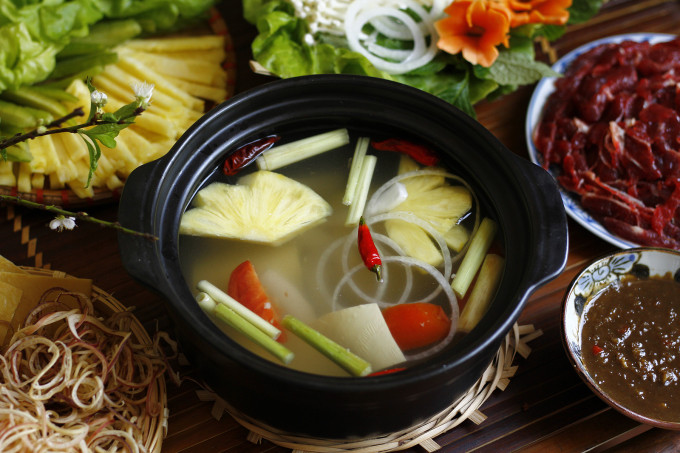
It is a balance of sour, sweet, salty and spicy tastes. The vinegar adds a sour and refreshing note to the broth, while the coconut juice adds a sweet touch. The lemongrass, onion and other spices add aroma and depth to the dish. The dipping sauce also enhances the flavor of the beef and adds a kick of spiciness.
Some of the popular cuts of beef that can be ordered for the hotpot are beef shank, beef tendon, beef tripe and beef balls. These cuts add more texture and variety to the dish. The dish allows the diners to interact and have fun with each other, as they cook their own food and customize their own rolls.
Lau vit om sau - Duck braised with dracontomelon
If you are looking for something to brighten up your day, look no further than lau vit om sau - duck braised with dracontomelon. This traditional dish from northern Vietnam is usually made in the summer, when sau (dracontomelon) are in season. Dracontomelon is a type of fruit that grows along the streets of Hanoi. It has a hard green skin and a yellow flesh with a sour and slightly sweet taste. It is also often used to make salted dried fruit or drinks.

The duck is marinated and then cooked slowly in a pot with water, vinegar, coconut juice, garlic and dracontomelon. The result is tender and juicy duck meat in a thick and creamy broth. The hotpot has a complex flavor that balances sourness, sweetness, and savoriness. The dish is perfect for hot summer days, as it has a refreshing and cooling effect on the body. It is also a comforting and satisfying dish that is ideal for weekends.
Lau rieu cua - Crab paste hotpot
If you love crabs and hotpots, you will love their combination in lau rieu cua, a mouthwatering dish from northern Vietnam. This dish uses the fresh freshwater crabs and transforms them into a rich and tangy broth with tomatoes, tender pieces of pork ribs, beef shank and tofu.
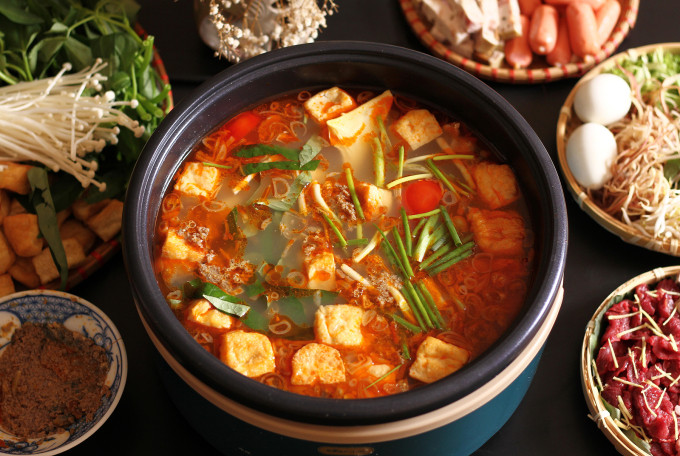
To make crab paste, the crabs are smashed into a paste and then strained with water to get rid of the shells. The resulting liquid is a dark brown broth that contains bits of crab meat. When you boil it in broth, the crab meat rises to the surface and creates a thick layer of paste. The broth is then simmered to bring out the best of the crab flavor. It is often eaten with a variety of fresh greens such as malabar spinach and sponge gourd.
The best part about this dish is that you can customize it to your liking. You can pick the meat, veggies and noodles that you want in your hotpot, and adjust the taste of the broth by adding more vinegar, tamarind or chili. Some people like their broth extra thick and crabby, while others prefer it lighter and clearer. Either way, you will enjoy the unique aroma and flavor of the crab paste that makes this dish so special. Lau rieu cua is a perfect dish for any season, but especially for cold days when you need something warm and cozy.
Lau ech - Frog and bamboo shoots hotpot
If you’re a fan of spicy food, you should check out lau ech, a hotpot dish from Hanoi. It will warm you up on cold winter days, and make you sweat on hot summer nights. Frog and bamboo shoots hotpot is not a dish that you can easily make at home. That's why most locals go out to eat it at specialized restaurants or street stalls.
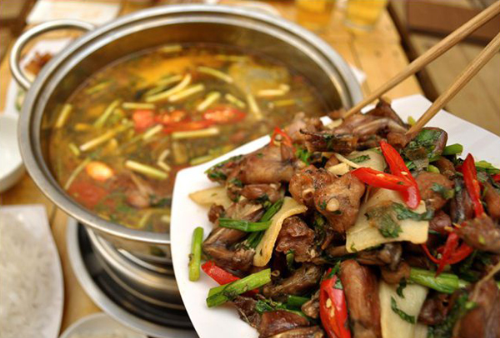
It takes a lot of work to prepare the frogs, which have to be skinned, gutted and chopped into bite-sized pieces. Then they are marinated with spices and stir-fried with bamboo shoots. Some places even deep-fry the frogs, making them extra crispy. The frog meat is lean and tender, with a texture similar to chicken, but more refined. The bamboo shoots add a nice crunch, and they also soak up the spicy broth. This frog hotpot is served with water spinach, which helps to balance out the heat and add some greens to your diet.
Lau ech is a dish that will make you appreciate the diversity and creativity of Vietnamese cuisine. Frog meat may seem strange to some outsiders, but it can please even the most picky eaters. This is a flavorful feast that delights the palate and fills the stomach.
Lau vit nau chao - Duck and fermented bean curd hotpot
Another fun and flavorful dish to warm you up on a chilly day is duck and fermented bean curd hotpot. This dish is a combination of tender duck meat and creamy fermented bean curd that creates a rich and satisfying broth. It is a specialty of the northern region of Vietnam.
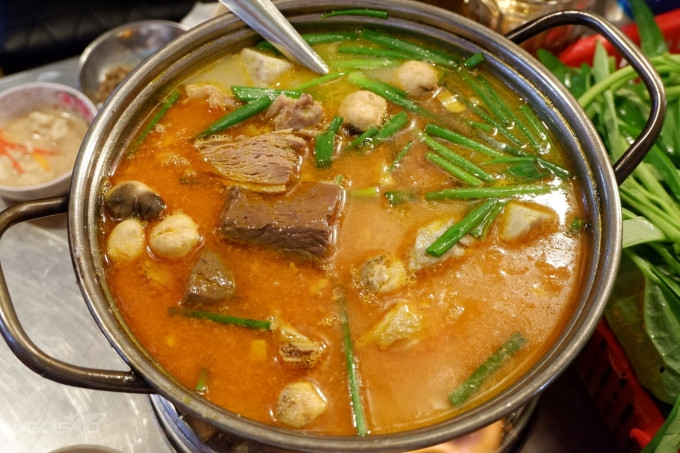
The duck is cut into bite-sized pieces and marinated with spices and chao, or fermented bean curd, which is made from soybeans that have a strong and pungent smell, but a mild and creamy taste. Chao is also mixed with water, sugar, lime and chili to make a sauce that you can dip your duck in for extra flavor. The duck and some taro are fried first to make them fragrant and then boiled to make the broth.
The hotpot is cooked until the duck meat is tender and the broth is rich and creamy. It is served with rice noodles, veggies and fresh herbs that you can add to your bowl as you like. The duck meat is tasty and moist, while the taro is soft and soaks up all the broth goodness. The broth has a bright red-yellow color from the chao, which makes it look delicious – and it tastes even better than it looks.
Lau chay - Vegan hotpot
Vegans in Vietnam are blessed with a variety of food choices. One of the best dishes you can try is Vietnamese vegan hotpot, or lau chay, a plant-based version of the traditional hotpot that usually features meat and seafood. It is a dish that is not only popular among vegans, but also food lovers of all ilks, thanks to its affordable price and great flavor.
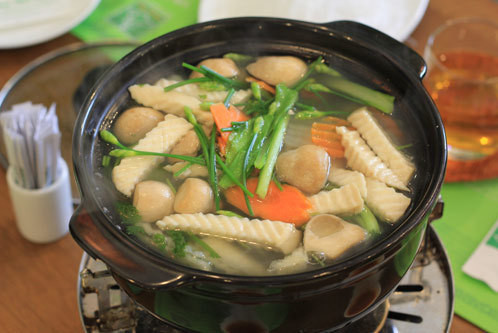
The vegan broth is made with vegetables, dried mushrooms, lemongrass, and spices. It is simmered until it becomes aromatic and rich in flavor. You can choose to add whatever toppings you like to the pot, such as mushrooms, tofu, taro, squash, corn, cabbage, water spinach and rice noodles to the hotpot. What makes lau chay beloved by everyone is also its dipping sauce. The dipping sauce is made of fermented bean curdand is rich and creamy, which adds an extra layer of flavor to the dish.
Lau hai san - Seafood hotpot
Seafood is an integral part of Vietnamese cuisine, and one of the most popular ways to enjoy it is by having a seafood hotpot. Seafood hotpot originated in the south of Vietnam, where fresh seafood is abundant and diverse. It is said that fishermen used to cook their catch in a pot over a fire on their boats. This simple but flavorful dish soon became popular among locals and visitors alike.
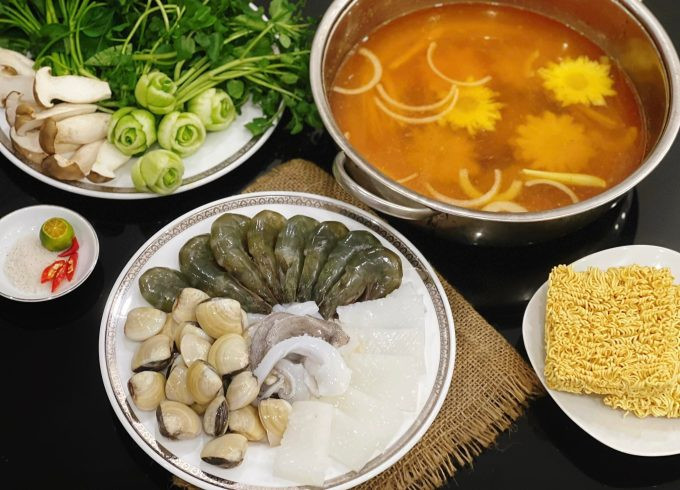
The seafood is the star of the seafood hotpot. It should be fresh, varied and generously-portioned. Some common seafood hotpot items are fish, shrimp, squid, crab, clam, and mussel. Depending on the availability and preference of each region, the seafood can vary. The broth is mostly made of bone broth, ginger, lemongrass, tomatoes and tamarind juice. Another version of lau hai san in Vietnam is called lau Thai, or Thai-style hotpot. This version is known for its spicy and sour flavors and includes ingredients such as lemongrass, kaffir lime leaves, and bird's eye chili.
Seafood hotpot has a rich flavor that balances saltiness, sourness and spiciness, with a touch of natural sweetness from the seafood. It is an easy dish to prepare at home, which makes it a great option for cozy and fun gatherings with family or friends.




